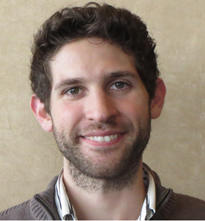
Armani Del Franco
E-MAIL: [email protected]
PhD: 2023
PhD Thesis
Astrocyte β-adrenergic receptor activity regulates neuronal NMDA receptor signaling.
Current Position:
Postdoctoral Fellow, Oregon Health Sciences University
Undergraduate Institution and Major:
University of Arizona, BSBA, Finance and Entrepreneurship, 2013
Arizona State University, B.S. in Biology, 2017
Graduate Advisor:
Eric A. Newman, Ph.D., Department of Neuroscience
Graduate Research:
Neuronal activity triggers an increase in blood flow to the central nervous system and is critical for maintaining appropriate O2 and nutrient levels. The breakdown of this neurovascular relationship, referred to as functional hyperemia, can result in a lack of nourishment to local areas of elevated neuronal activity. While mounting evidence indicates capillaries can actively dilate, the contribution of this dilation to functional hyperemia is currently unknown. Our goal is to determine the extent to which active capillary dilation contributes to functional hyperemia. We hypothesize that: With the experimental elimination of active capillary dilation, there will be reductions in overall changes to blood flow in response to increased neuronal activity.
Publications:
- Astrocyte β-adrenergic receptor activity regulates NMDA receptor signaling of medial prefrontal cortex pyramidal neurons. J Neurosci. 2024 Jan 10;44(2):e0990232023.
- Del Franco AP, Chiang PP, Newman EA. Dilation of cortical capillaries is not related to astrocyte calcium signaling. Glia. 2022;70(3):508-521.
- Astrocyte regulation of cerebral blood flow during hypoglycemia. J Cereb Blood Flow Metab. 2022 Aug;42(8):1534-1546.
Graduate Oral Presentations:
- Regulation of blood flow through cerebral capillaries. Graduate Program in Neuroscience Colloquium Series. March 17 2021.
Graduate Awards
- Doctoral Dissertation Fellowship 2022-2023
Thesis Committee Members:
Alfonso Araque, Ph.D., Department of Neuroscience (Chair)
Eric Newman, Ph.D., Department of Neuroscience
Julia Lemos, Ph.D., Department of Neuroscience
Stanley Thayer, Ph.D., Department of Pharmacology
Rotations:
Eric A. Newman, Ph.D., Department of Neuroscience
Yasushi Nakagawa, Ph.D., Department of Neuroscience
Alfonso Araque, Ph.D., Department of Neuroscience
Paulo Kofuji, Ph.D., Department of Neuroscience
Undergraduate or Post-Bac Research:
I worked in Dr. Cassandra Gipson's lab, using the glutamate homeostasis hypothesis of addiction, focusing on glutamatergic signaling during nicotine self-administration, withdrawal, and reinstatement. I helped to examine the impact of N-acetyl cysteine (NAC), an antioxidant found to have some clinical efficacy in reducing craving of cocaine and marijuana, on reinstatement and restoration of glutamate transporter (GLT1) expression. As well, I have helped conduct a study on the impact of nicotinic acetylcholine receptors on cue-induced nicotine seeking and rapid, transient synaptic plasticity in the nucleus accumbens core. These studies have fueled my passion to understand how astrocytes interact with synapses, their intracellular signaling, and plasticity.
Undergraduate Publications:
- Powell GL, Leyrer-Jackson JM, Goenaga J, Namba MD, Piña J, Spencer S, Stankeviciute N, Schwartz D, Allen NP, Del Franco AP, McClure EA, Olive MF, Gipson CD. Chronic treatment with N-acetylcysteine decreases extinction responding and reduces cue-induced nicotine-seeking. Physiol Rep. 2019 Jan;7(1):e13958.
- Overby PF, Daniels CW, Del Franco A, Goenaga J, Powell GL, Gipson CD, Sanabria F. Effects of nicotine self-administration on incentive salience in male Sprague Dawley rats. Psychopharmacology. 2018 Apr;235:1121-1130.
- Foster Olive M, Del Franco AP, Gipson CD. Diolistic labeling and analysis of dendritic spines. Methods Mol Biol. 2018;1727:179-200.
Undergraduate Awards:
- College of Liberal Arts and Sciences (CLAS) Undergraduate Summer Enrichment Award for research on changes in spine morphology of nucleus accumbens medium spiny neurons during nicotine self-administration and subsequent reinstatement. May 2016 – August 2016
- School of Life Sciences Undergraduate Travel Grant to present our lab’s poster at the College on Problems of Drug Dependence Conference, May 2016
- School of Life Sciences Undergraduate Research (SOLUR) for research on changes in spine morphology of nucleus accumbens medium spiny neurons during nicotine self-administration and subsequent reinstatement. August 2016 – May 2017
What Got You Interested In Research?
Coming from a business background, I became quite bored of the corporate world and started asking myself what I truly enjoyed growing up. Having continued to read books on science and always enjoyed catching bugs and conducting experiments with my cousins, I read The Other Brain by Douglas Fields, which changed my life’s trajectory. He used the book to describe exciting research in glial cells, and I just had to know more for myself! I remember being shocked, that there were other cells in the brain beside neurons, and I want to contribute to making sure everyone understands the crucial roles glia contribute to the nervous system.
Why Did You Choose MN?
My classmates can attest to my absolute love of astrocytes, whether it’s thinking about them, drawing them, trying to design experiments around them in my free time. My journey into Neuroscience was to allow me to study and advance our understanding of astrocytes. Minnesota happens to have an incredible number of faculty that are experts in the field of astrocytes and applying their modulation in different circuits. Part of this decision also comes from how collaborative everyone is here, faculty and students!
Student Mentor and the Best Advice They Gave:
Justin Lines: He made it a point to remind me that you have to take time for yourself and spend time with others, because it’s the people that truly make the experience. As well, you’ll do your best thinking when taking time away from the bench.
Favorite Itasca Memory:
My favorite Itasca memory was getting everyone out onto the lake that first weekend, and forming a giant flotilla, tying all the boats together, as a way to get together, soak up the sun, and celebrate Chloe's birthday!
